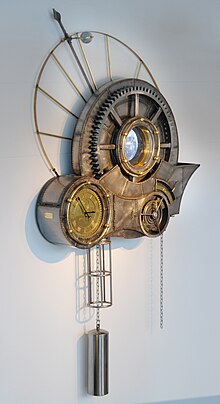發條宇宙
外观

在科学史上,发条宇宙把宇宙比喻作机械钟。它是一台完美的机器,一直运转。其機器受物理定律控制,从而使机器在各个方面都可预测的。
历史
[编辑]这个观点在启蒙時代中受到自然神論者广泛欢迎,当艾萨克牛顿提出牛頓运动定律時,证明除了万有引力外,它们還可以预测物理運動和太阳系的運作。
在13世紀早期,天文學家約翰尼斯·德·薩克羅博斯科提出了《论世界》。約翰尼斯·德·薩克羅博斯科認為宇宙就如世界的机器,因此,耶稣被钉十字架上時日蚀的出現就是对机器秩序的干扰,这段論說在中世纪時得到廣泛流行。 [1]
這理论的主要支持者戈特弗里德·莱布尼兹[2]對此做出了回应,他在莱布尼兹-克拉克的書信中写道:
- “世界是一个伟大的机器概念,即使没有上帝的介入仍可继续进行,因为时钟在没有钟表匠的协助下仍可继续运转。這是唯物主义和命运的概念,并且趋向于把天意和上帝的政府排除在现实世界之外。” [3]
2009年,艺术家蒂姆·韦瑟雷尔(Tim Wetherell)为国家科学技术中心创作了一块大型壁画,這代表了发条宇宙的概念。这张钢制艺术品包含活动齿轮、工作时钟和晨昏圈的展示。
參看
[编辑]參考文獻
[编辑]- ^ John of Sacrbosco, On the Sphere, quoted in Edward Grant, A Source Book in Medieval Science, (Cambridge: Harvard Univ. Pr., 1974), p. 465.
- ^ Danielson, Dennis Richard. The Book of the Cosmos: Imagining the Universe from Heraclitus to Hawking. Basic Books. 2000: 246. ISBN 0738202479.
- ^ Davis, Edward B. 1991. "Newton's rejection of the "Newtonian world view" : the role of divine will in Newton's natural philosophy." Science and Christian Belief 3, no. 2: 103-117. Clarke quotation taken from article.
延伸阅读
[编辑]- E. J. Dijksterhuis (1961) The Mechanization of the World Picture, Oxford University Press
- Dolnick, Edward (2011) The Clockwork Universe: Isaac Newton, the Royal Society, and the Birth of the Modern World, Harper Collins.
- David Brewster (1850) "A Short Scheme of the True Religion", manuscript quoted in Memoirs of the Life, Writings and Discoveries of Sir Isaac Newton, cited in Dolnick, page 65.
- Webb, R.K. ed. Knud Haakonssen (1996) "The Emergence of Rational Dissent." Enlightenment and Religion: Rational Dissent in Eighteenth-Century Britain, Cambridge University Press page 19.
- Westfall, Richard S. Science and Religion in Seventeenth-Century England. p. 201.
- Riskins, Jessica (2016) The Restless Clock: A History of the Centuries-Long Argument over What Makes Living Things Tick, University of Chicago Press.
外部链接
[编辑]- "The Clockwork Universe". (页面存档备份,存于互联网档案馆) The Physical World. Ed. John Bolton, Alan Durrant, Robert Lambourne, Joy Manners, Andrew Norton.
